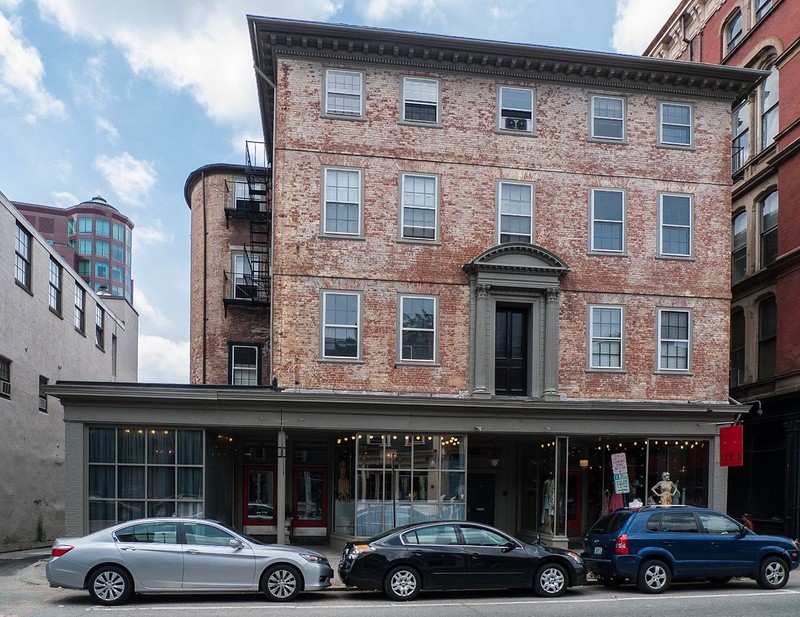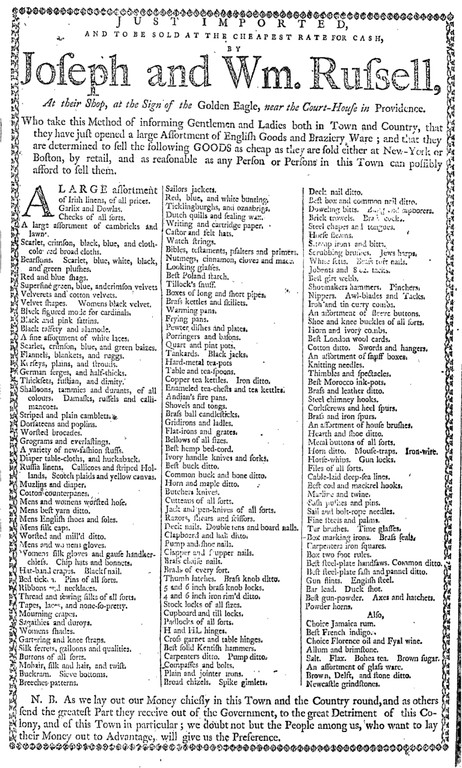Joseph and William Russell House
Introduction
Text-to-speech Audio
Constructed in 1772, the Russell house stands as a monument to a time when the Atlantic World economy -- including the slave trade -- was the cornerstone of Providence and the economic engine behind the growth of the American colonies. Joseph and William Russell were two of the leading merchants in colonial Providence thanks to their participation in the trade with the West Indies. This building was the first three-story structure in Providence. The British blockade of shipping lanes during the Revolutionary War caused the Russell Brothers to suffer financial peril, forcing them to sell the house in 1798 to another prominent Providence resident, John Corliss.
Images
2014 Picture of the Russell House, now raised one story, which is why the doorway is not located on the ground level.

A comprehensive list of goods imported by the Russell brothers to sell at their store, placed on an ad in the Providence Gazette in November 29, 1766.

Backstory and Context
Text-to-speech Audio
The Russell house (1772) is a remnant of an era when Atlantic World trade, was in full-force and consumer culture in the American colonies had significantly grown in power and influence. The house is a monument to a time when Providence overtook Newport as the commercial hub. The Russell's skill in mastering trade relations with other merchants and shippers in the West Indies allowed their store -- The Sign of the Golden Eagle -- to sell vast amounts of imported fabrics, exotic spices, fine housewares, and large casks of rum. The rum trade was an industry heavily dependent upon slave labor.
The house was the second brick edifice and the first three-story structure in Providence, a sign that city was in the process of overtaking Newport as the local urban hub. The elegant entrance and luxuriant interior point to the common practice of American architects during that era to copy from English design books. The house design, as well as the brothers' work as retailers of goods, point to a Colonial culture where many had aspired to live in a manner akin to the English gentry class demonstrating the connection between social status and conspicuous consumption and display of material wealth.
An intriguing feature of the house, as it appears today, is its entry door that exists on the second floor rather than at the ground level, a consequence of the house being raised one story in 1875 as part of its transformation into the Clarendon Hotel. In 1920 the building was purchased by Joseph Blazer, a retail merchant in Providence. Blazer sold many of the interior items from the late colonial period to museums such as Brooklyn Museum, the Minneapolis Art Museum and the Museum of the Rhode Island School of Design.
Goods shipped by Russell Brothers, per their store's newspaper advertisements, as described by the Minneapolis Institute of Art at (https://new.artsmia.org/living-rooms/just-imported/)
Sugar Cone & Nippers
Sugar, a precious commodity in the 1700s, would have come in a hardened cone shape and wrapped in paper. Nippers were used to pinch off the desired amount
Spices & Tea
Spices and teas were sourced from many different countries in Asia, such as Indonesia, India, China, and islands nearby. Consumers used them as food preservatives, flavor enhancements, and stimulants, much as they do today.
Molasses
Molasses is a syrupy by-product of the refinement process of sugarcane. It is the key ingredient in the manufacture of rum, one of the Colonies’ main exports. Sugarcane was grown in the West Indies through the labor of enslaved people.
Indigo
An advertisement for The Sign of the Golden Eagle offers “French indigo,” probably from the French colony of Saint Domingue (Haiti). Like sugarcane, indigo was a crop grown by enslaved people.
Tobacco
An export good from the Colonies to Europe and Africa, tobacco was grown in Southern plantations that relied on the labor of enslaved Africans.
Jamaican Rum
West Indies molasses was distilled into rum in Providence for export and local consumption.
Olive Oil
Olive oil was enjoyed by many in colonial Rhode Island, including Portuguese whalers and fishermen who crewed ships, and the growing Jewish community, also from Portugal.
Writing Set
Before phones and computers, correspondence was handwritten. Writing tools and materials like quills, ink, and inkpots were in high demand.
Clay Pipes
A clay pipe would have made a useful companion to New World tobacco, grown in the southern Colonies.
Escutcheons
Brass drawer handles, pulls, and key locks were desirable goods for the elegantly furnished Colonial home.
Horn Comb
Grooming items like this comb were typically made of tortoise shell, ivory, or horn.
Sealing Wax & Stamp
Stationery items like sealing wax and stamps kept personal and business letters shut and safe from prying eyes.
Hemp Rope
Ropes, used in ship rigging, would have been common around the harbor.
Codfish
A New England export, codfish would have been salted to preserve it for transport to the West Indies.
Metal Buttons
Apparel goods, like fabrics and finishes, were popular import items to the Colonies.
Buckram, Western Europe (probably invented in Bukhara, Uzbekistan)
Starched open-weave canvas. Used as a stiffening agent in clothing and furnishings.
Cambricks, Flanders, France
Plainwoven white textiles typically made of linen. Used in high-quality collars and ties for men, sleeve ruffles, and women’s collars and shawls.
Checks, India
Low-quality striped or checkered cottons. Used for clothing and household uses.
Velvet, Western Europe
A luxury fabric made of silk or cotton, in which case called velveteen or velveret. Used for curtains and fine garments.
Broadcloths, England
Thick, durable, weatherproof woolens. Used for outdoor activewear like military coats and women’s riding outfits.
Sources
Grady, Timothy P. “Contact and Conquest in Africa and the Americas,” in The Atlantic World:
1450-2000. Edited by Toyin Falola and Kevin D. Roberts. Bloomington: Indiana University Press, 2008.
Howell, Mark, Emma L. Powers, et al. Buying Respectability: The Consumer Revolution in Colonial Virginia. 2000. Staff Resource Manual developed by the Colonial Williamsburg Foundation Department of Historical Research. http://www.history.org/history/teaching/enewsletter/volume5/december06/consumer_rev.cfm
"Joseph and William Russell." The Adverts 250 Projects: An Exploration of Advertising in Colonial America 250 Years Ago This Week. https://adverts250project.org/2018/07/23/july-23-3/ ; https://adverts250project.org/2016/11/ ; and https://adverts250project.org/2018/07/02/july-2-3/
"Just Imported: Global Trade in 1700s New England." Minneapolis Institute of Art. Accessed September 07, 2018. https://new.artsmia.org/living-rooms/just-imported/
Nash, Gary. The Unknown American Revolution: The Unruly Birth of Democracy and the Struggle to Create America. New York: Penguin Books, 2005.
"Provenance: Joseph and William Russell House." Eron Johnson Antiques: Centuries of Design. Accessed September 07, 2018. https://eronjohnsonantiques.com/pages/provenance-joseph-and-william-russell-house.
Wood, Gordon. The Radicalism of the American Revolution. New York: Vintage Books,
1991.
Photo Sources
By Kenneth C. Zirkel - Own work, CC BY-SA 4.0, https://commons.wikimedia.org/w/index.php?curid=38280623
Advertisement: Located at THE ADVERTS 250 PROJECT, https://adverts250project.org/2016/11/
Photo Sources
By Kenneth C. Zirkel - Own work, CC BY-SA 4.0, https://commons.wikimedia.org/w/index.php?curid=38280623
Advertisement: Located at THE ADVERTS 250 PROJECT, https://adverts250project.org/2016/11/
